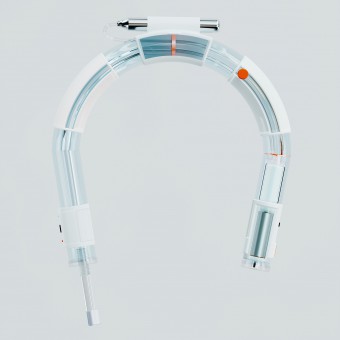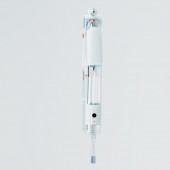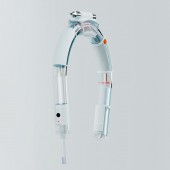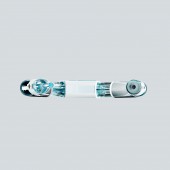DESIGN NAME:
OBS
PRIMARY FUNCTION:
Wearable devices that simulate the ocean
INSPIRATION:
Inspired by conversations with my uncle, a seasoned boat captain with over a decade of experience, I've gained insight into the distressing changes occurring in our oceans. He's observed a noticeable decline in coral and marine plants, a phenomenon further exacerbated by extensive coral bleaching. Alarmingly, he's also encountered soft-shelled crabs, indicating a broader ecological imbalance. These firsthand accounts have profoundly influenced the conception of my project, driving home the urge
UNIQUE PROPERTIES / PROJECT DESCRIPTION:
This wearable device combats ocean acidification by syncing with ocean oxygen levels and simulating marine breathing, fostering marine conservation awareness. Utilizing Arduino and Python for real-time data, it blends technology with environmental science to promote action against CO2 emissions. Aimed at enhancing public engagement in ocean preservation, this project marks a significant innovation in addressing environmental challenges, showcasing a commitment to the planet's health.
OPERATION / FLOW / INTERACTION:
The government/agency collects ocean data then the software captures it and sends it to the wearable device, the wearable device adjusts the oxygen production value Gas sensor detects and matches the respiratory rate, the data receiving device shows the value to the user and finally the user can visualise the state of the ocean.
PROJECT DURATION AND LOCATION:
Project started in Shanghai in October 2022 and completed in Shanghai in January 2023
FITS BEST INTO CATEGORY:
Idea and Conceptual Design
|
PRODUCTION / REALIZATION TECHNOLOGY:
Our device uses electrolysis, controlled by an Arduino microcontroller, to simulate marine breathing environments. It splits water into oxygen, aligning with ocean's dissolved oxygen via real-time Python web scraping data. Sustainable materials ensure minimal environmental impact, fostering a deep connection with marine conservation through innovative technical solutions.
SPECIFICATIONS / TECHNICAL PROPERTIES:
260*270mm
TAGS:
Climate Change , Ocean Acidification , Low Carbon Living , Sea Level Rise , Warming .
RESEARCH ABSTRACT:
In this design research, we explore an innovative wearable device aimed at addressing the threat of ocean acidification to marine algae—the planet's primary oxygen producers—under the backdrop of global warming, and its impact on the decline of global oxygen levels. The primary goal of the research is to raise public awareness about marine conservation and promote the reduction of carbon dioxide emissions to improve the Earth's environment. This is achieved through a wearable device that simulates the breathing experience of marine life in different ocean regions. The device consists of an oxygen production unit and a synchronization unit, with the technical implementation based primarily on Arduino and data on dissolved oxygen content in various marine areas collected via Python web scraping from public websites.
The research method involves the application of interdisciplinary techniques, including environmental science, electronic engineering, and computer science, ensuring the device is both scientifically accurate and practical. Data collection is automated through web scraping from designated marine science websites, ensuring timeliness and accuracy of the data. Moreover, the design process adheres to principles of user experience design, ensuring comfort and ease of use of the wearable device.
Experimental testing demonstrated that the device successfully simulates the breathing sensations of different marine environments. Participant feedback indicated that using the device deepened their understanding and awareness of marine environmental issues. Furthermore, the research sparked widespread public discussion on marine conservation, contributing to increased societal emphasis on environmental protection.
In summary, this research not only showcases the potential application of technology in environmental conservation but also offers a new avenue for engaging the public in environmental protection efforts. The design poses potential innovation for the business sector in creating eco-friendly products and promotes attention and action towards climate change and marine conservation issues in society. Through this innovative design, we aim to ignite a passion for environmental protection among more people, working together to improve our Earth's environment.
CHALLENGE:
During the development and implementation of our project, we faced several creative challenges and obstacles, both from internal perspectives like historical and societal considerations, and external factors such as legal restrictions, production feasibility, information availability, and technology.
Internal Factors:
Historical Perspective: We had to navigate the historical failures and successes of similar environmental tech projects to innovate without repeating past mistakes.
Societal Perspective: Addressing societal apathy towards environmental issues required us to design an engaging and educational user experience that could resonate with a broad audience.
External Factors:
Legal: Complying with international and local environmental laws and regulations regarding data collection and device deployment posed significant hurdles.
Production Feasibility: Balancing the cost of advanced technology to ensure affordability while maintaining device effectiveness was challenging.
Information Availability: Gathering real-time, accurate marine data required overcoming the limitations of existing public datasets and ensuring the reliability of data sources.
Technology: Integrating Arduino with advanced sensors for oxygen production and synchronization while ensuring the device's wearability and user-friendliness pushed the limits of current wearable tech.
We overcame these obstacles through extensive research, iterative design, collaboration with environmental scientists for accurate data, legal consultations, and leveraging open-source technologies to keep costs down while ensuring robust functionality.
ADDED DATE:
2024-02-10 05:11:17
TEAM MEMBERS (1) :
IMAGE CREDITS:
Zikai Ge, 2023.
|










